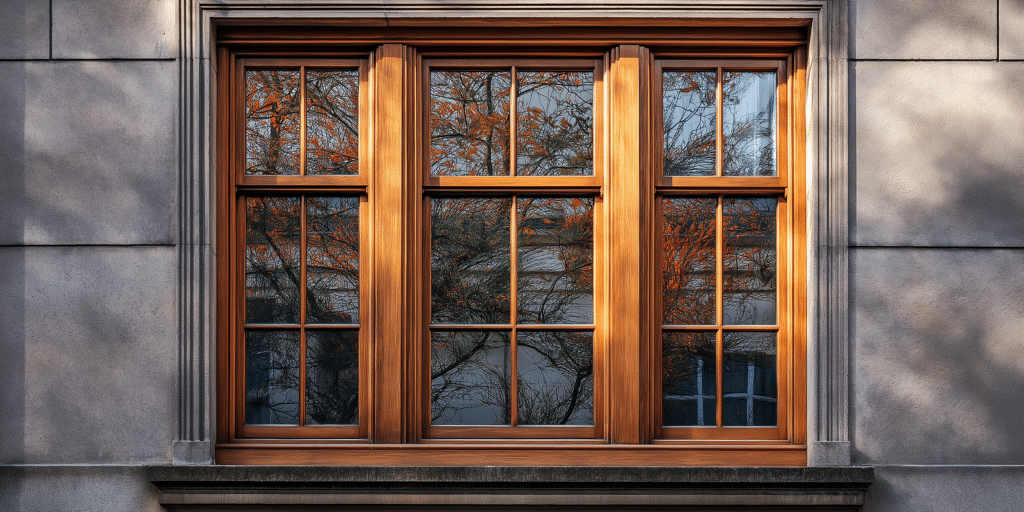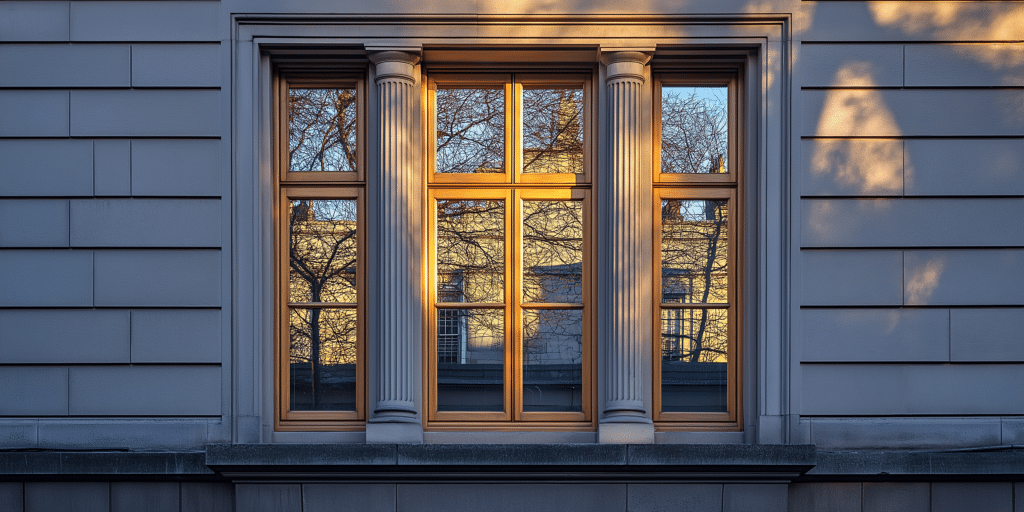Introduction to Sash Windows and Transoms

Despite modern window innovations, sash windows remain popular, especially in period properties, due to their classic appearance and the ability to be fitted with modern enhancements like double glazing and draught-proofing. The larger, thicker glass panes used in sash windows are more desirable for their aesthetic and functional properties.
A transom can increase the amount of natural light and ventilation in a space, making it an excellent choice for areas where these features are desirable. Additionally, transoms often serve a decorative function, adding architectural interest to a building.
The choice of materials (e.g., timber, uPVC, aluminium) and design (e.g., single-hung, double-hung) influences the window’s thermal performance, durability, and aesthetic appeal. As noted by experts, wood is often preferred for its natural appearance and excellent insulation properties, while modern materials like uPVC and aluminium are valued for their low maintenance and durability.
The Historical Significance of Sash Windows with Transoms
Sash windows with transoms have a long history, particularly in Georgian and Victorian architecture, where they were used extensively in both residential and public buildings. This style was later embraced by the Victorian era, which saw further refinements in both the aesthetic and functional aspects of the windows. The design of sash windows has evolved from simple, single-pane sashes to more complex configurations with multiple panes and decorative elements like transoms. This evolution reflects changes in architectural styles and advances in window technology.
Transoms were popular in historical buildings because they provided additional light and ventilation while maintaining the structural integrity of large windows and doors. This feature was particularly useful in tall, narrow buildings where natural light was limited.
In listed buildings, preserving original sash windows with transoms is often a priority. Conservation techniques include careful restoration, using period-appropriate materials, and installing secondary glazing to improve energy efficiency without compromising the building’s historical character.
Types of Sash Windows with Transoms
There are several types of sash windows that can feature transoms, including single-hung, double-hung, and more specialised designs like Venetian or Palladian windows. Each offering different levels of functionality and aesthetic appeal. Venetian-style windows are also notable for their use of transoms, often seen in grand, classical-style buildings.
Single-hung sash windows have a fixed top sash and a movable bottom sash, while double-hung windows allow both sashes to move independently, providing greater ventilation options. Both can include a transom for additional functionality.
A Venetian sash window typically features a large central sash flanked by narrower sashes, with a transom window above the central sash. This design is both functional and decorative, often found in grand, classical-style buildings.
The choice of sash window type depends on factors like the architectural style of the building, the desired level of ventilation and light, and personal aesthetic preferences. For example, Georgian buildings might benefit from traditional multi-pane sash windows with transoms, while a modern home might favour a minimalist, single-hung design.
Materials Used in Sash Windows with Transoms
Sash windows with transoms can be made from a variety of materials, including timber, uPVC, aluminium, and composite materials. Each material offers different benefits in terms of aesthetics, durability, and thermal performance.
- Timber is a traditional material that offers excellent insulation and can be easily customised. It’s particularly valued in historical renovations for its authentic appearance and compatibility with period architecture.
- uPVC and aluminium offer low maintenance and high durability, making them popular choices for modern sash windows with transoms. uPVC provides excellent insulation, while aluminium is known for its strength and slim profile, allowing for larger panes of glass. Composite windows combine the best features of different materials, often using timber on the interior for aesthetic appeal and uPVC or aluminium on the exterior for weather resistance. This combination provides a balance of performance, durability, and appearance.
Design Considerations for Sash Windows with Transoms

Key design elements include the number of panes, the style of glazing bars (e.g., Georgian, astragal), the proportions of the window and transom, and the overall architectural style of the building. For instance, using narrower muntins allows for larger panes and more light, a feature often utilised in Victorian and Edwardian sash windows.
Glazing bars divide the sash into smaller panes, which can enhance the window’s traditional look. Georgian-style sash windows often feature multiple glazing bars, creating a grid pattern, while Victorian designs may have fewer, larger panes.
The proportion of the transom relative to the window can affect both the aesthetic balance and the amount of light that enters the room. A well-proportioned transom complements the overall window design, contributing to the building’s visual harmony. The choice of sash windows and transoms should be consistent with the architectural style of the building. For example, Georgian architecture typically features symmetrical sash windows with small panes and prominent transoms, while Victorian designs may incorporate more ornate detailing and larger glass panes.
Installation and Maintenance of Sash Windows with Transoms
Installation involves several key steps, including measuring the window opening, preparing the frame, fitting the sashes and transom, and ensuring proper sealing and weatherproofing. Professional installation is recommended to ensure the windows operate smoothly and efficiently.
Regular maintenance, such as painting, glazing, and checking the sash cords and weights, is essential to keep sash windows with transoms in good working order. This maintenance helps prevent issues like draughts, rattling, and sticking sashes.
Common issues include broken sash cords, rotting timber, and loose glazing bars. These problems can often be resolved through repairs such as replacing cords, treating or replacing timber, and re-glazing.
Modern enhancements, such as double glazing, draught-proofing, and the use of high-performance materials, can significantly improve the thermal efficiency and soundproofing of sash windows with transoms while preserving their traditional appearance.
Energy Efficiency and Environmental Impact
The energy efficiency of sash windows with transoms depends on factors such as the materials used, the type of glazing, and the quality of installation. Modern sash windows can be fitted with energy-efficient glazing and seals to reduce heat loss. It’s noted that sash windows with transoms fitted with double glazing can reduce heat loss by up to 30% compared to single-glazed windows.
Double glazing involves two panes of glass with a space between them, which acts as an insulator. This can significantly reduce heat loss compared to single glazing, making sash windows with transoms more energy-efficient. Using sustainably sourced timber, installing energy-efficient glazing, and maintaining the windows to extend their lifespan all contribute to the environmental sustainability of sash windows with transoms.
Retrofitting options include adding secondary glazing, upgrading to double or triple glazing, and installing draught-proofing measures. These upgrades can help reduce energy consumption and improve the overall performance of the windows.
Security Features in Sash Windows with Transoms
Sash windows, particularly older models, can be vulnerable to forced entry if they are not properly secured. Common concerns include weak locks, loose frames, and accessible sash cords.
Modern security features include reinforced locks, security glazing, and sash stops, which prevent the window from being opened too far. These features can greatly enhance the security of sash windows with transoms without compromising their aesthetic appeal.
Laminated or toughened glass provides added protection against break-ins, as these types of glass are more difficult to shatter. They also offer additional benefits such as improved sound insulation and resistance to impact.
Window sensors and alarms can be discreetly integrated into the frames of sash windows with transoms, providing an additional layer of security. These systems can alert homeowners to potential intrusions and are often compatible with smart home security setups.
Aesthetic and Architectural Value

Sash windows with transoms are highly regarded for their timeless aesthetic, which adds character and charm to a building. Their elegant proportions and traditional detailing make them a popular choice for both period properties and contemporary homes seeking a classic touch.
These windows can highlight architectural features such as high ceilings, decorative mouldings, and period facades. The transom, in particular, adds vertical emphasis, drawing the eye upwards and enhancing the sense of space and light.
Glazing patterns, such as Georgian bars or leaded lights, contribute to the window’s visual interest and historical authenticity. These patterns can be customised to complement the architectural style of the building, whether traditional or modern. The colour and finish of the window frames play a significant role in the overall aesthetic. For instance, painted timber frames can be matched to the building’s exterior colour scheme, while natural wood finishes can enhance the building’s rustic or traditional appeal.
Common Challenges and Solutions
Common challenges include draughts, rattling, sticking sashes, and condensation. These issues can affect the window’s performance and comfort levels within the building.
Draught-proofing involves sealing gaps around the sashes and frame, which can significantly reduce heat loss and improve comfort. This simple upgrade can also help reduce noise infiltration and prevent rattling.
Condensation can be addressed by improving ventilation, installing double glazing, or using moisture-absorbing materials within the window assembly. Ensuring proper insulation and ventilation helps to maintain a comfortable indoor environment.
Professional restoration can address issues such as wood rot, broken sash cords, and loose glazing bars. By restoring the windows to their original condition and upgrading them with modern features, you can extend their lifespan and enhance their performance.
Customisation Options for Sash Windows with Transoms
Customisation options include choosing the number and arrangement of panes, the style of glazing bars, the type of glazing (e.g., frosted, stained, or clear), and the finish of the window frames. Custom glazing, such as low-emissivity (Low-E) glass or acoustic glazing, can improve the window’s energy efficiency and sound insulation. These options allow you to tailor the windows to specific environmental conditions or performance requirements.
Matching the customisation options with the building’s architectural style ensures that the windows enhance rather than detract from the building’s overall appearance. For example, traditional glazing patterns and timber frames are ideal for period properties, while sleek, minimalist designs might suit a contemporary home.
Bespoke designs allow you to create unique windows that perfectly complement your home’s aesthetic. Whether you choose intricate glazing patterns, custom frame colours, or specialised hardware, bespoke sash windows with transoms can significantly enhance your property’s value and appeal.
Final Thoughts on Sash Windows with Transoms
Sash windows with transoms offer a blend of traditional charm and modern performance, making them a timeless choice for both new builds and renovation projects. Their versatility and aesthetic appeal ensure they remain a popular option across different architectural styles.
Investing in high-quality sash windows with transoms can enhance your property’s energy efficiency, security, and aesthetic value. By choosing the right materials and customisation options, you can ensure your windows meet your needs for many years to come.




